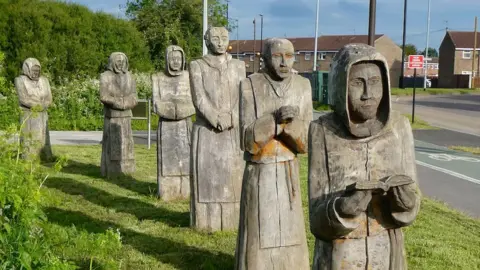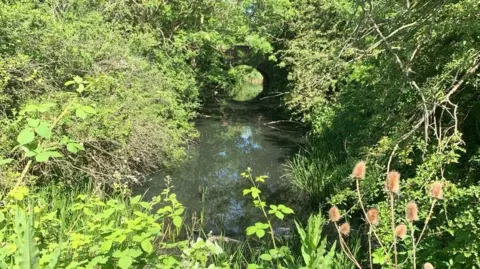How ruined abbey gave rise to an urban ghost story
 Paul Harrop/Geograph/CCL
Paul Harrop/Geograph/CCLAt a roundabout on a housing estate in Hull, six monks, their cowls up and arms folded, tread a lonely furrow, oblivious to the busy traffic around them.
The carved-wood statues reference a long-standing urban legend in and around Bransholme.
For years, residents have reported seeing apparitions here.
"People think they've seen a ghost," says Neil Chadwick, a librarian archivist at Hull History Centre. "A ghostly figure, wearing a habit or a robe."
The "figures" have been connected to waterways, including the Foredyke Stream, which runs past the statues, and Holderness Drain.
Speaking to the BBC's Hidden East Yorkshire podcast, Neil, who grew up on the estate, adds: "It could be shadows, it could be animals, it could be people just not quite seeing what is actually there.
"I don't necessarily believe or disbelieve, but I do kind of entertain the idea."
But why monks? A few miles to the north of Bransholme lies the site of Meaux Abbey. Though little can be seen today, it was once a thriving Cistercian community.
The abbey was founded in about 1150 by William le Gros, the Earl of York.
"He acquired the name le Gros because of his size - he was said to be very, very fat in later life," says Neil.
The monks of Meaux developed a network of ditches to drain the land for farming. And in a time when there were few roads, the waterways would have been used for transporting people and goods between the abbey and the River Hull.
"To 21st Century eyes, we see quite a nice landscape around there, but back in the Middle Ages, it was a very barren, very hostile environment," Neil says.
"It needed to be tamed and that's what the monks were there to do. They were there to drain the land, make it more arable, be able to settle there, be able to farm."

Life for the monks would have been difficult at times.
"It's perfectly plausible that some monks may have met a sudden or terrible end by working the landscape.
"Things like flash floods may have occurred, some of the drains collapsing on them. We know the River Hull altered its course in the mid-13th Century due to terrible rainfall, which literally altered the course to the course that we see today."
Then in 1348 to 1349, the Black Death struck. It took out probably the vast majority of the monks.
"It would have been a painful, agonising and a really horrible, slow death for some of the monks, so perhaps that's the reason that these ghostly apparitions still appear.
"People put two and two together."
Meaux Abbey was demolished in 1542 to provide stone for Henry VIII's castle and walls in Hull. Today, only earthworks remain.
And while many people will dismiss the idea of ghostly monks haunting a housing estate, the tales do serve, at least, to keep the history of the site alive.
Visit BBC Sounds to listen to the full series of Hidden East Yorkshire.
Listen to highlights from Hull and East Yorkshire on BBC Sounds, watch the latest episode of Look North or tell us about a story you think we should be covering here.
